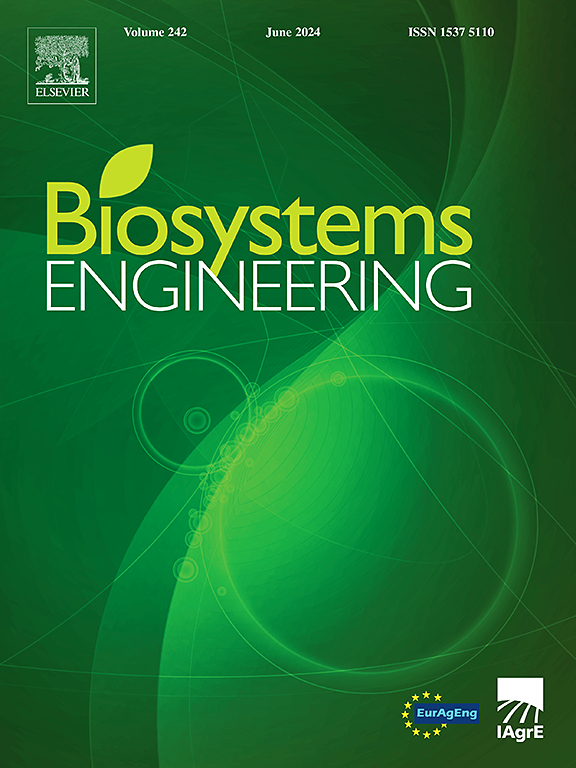通过在不同类型的地板上使用消毒剂,抑制脲酶活性以减少奶牛场的氨排放
IF 5.3
1区 农林科学
Q1 AGRICULTURAL ENGINEERING
引用次数: 0
摘要
限制畜棚地板上脲酶的活性提供了一种以源头为导向的方法来减少奶牛场的氨(NH3)排放。本研究旨在寻找有前景的消毒剂,并测试最佳使用频率以降低脲酶活性。首先,我们研究了喷洒消毒剂(中性电解氧化水(N-EOW)、过氧乙酸(PAA)、盐酸和甲醛)对标准混凝土板条(SCS)地板、塑料涂层板条(PSL)地板和沟槽固体(GSO)地板脲酶活性的短期和长期影响。对有前景的消毒剂进行了最佳喷洒频率测试。最后,我们测试了N-EOW和PAA对NH3排放的影响。PSL地板脲酶活性显著低于SCS和GSO地板,分别为52、254和2004mg (NH4+ -N) m−2 h−1 (P <;0.001)。与水和其他消毒剂相比,PAA和N-EOW对脲酶活性有较好的降低作用。长期降低脲酶活性(120 h), PAA和N-EOW分别为76%和50%。在每周喷洒期间,施用后立即对GSO地板进行N-EOW和PAA的平均脲酶还原效率分别为76%和78%,但一周后分别降至29%和34%。虽然PAA是一种众所周知的氧化剂,但N-EOW可能是一种对动物和环境更安全的解决方案。该研究深入了解了消毒剂喷洒(例如,每1-2天喷洒N-EOW)与频繁清除粪便相结合以减少NH3排放的潜力。然而,在将结果转化为实践时,仍然需要进行全面的评价。本文章由计算机程序翻译,如有差异,请以英文原文为准。
Inhibiting urease activity to reduce ammonia emissions from dairy houses through application of disinfectants on different floor types
Limiting urease activity on barn floors offers a source-oriented approach to reduce ammonia (NH3) emissions from dairy houses. This study aimed to find promising disinfectants and test the optimal application frequency to reduce urease activity. First, we investigated the short-term and long-term impact of spraying disinfectants (neutral electrolysed oxidising water (N-EOW), peracetic acid (PAA), hydrochloric acid and formaldehyde) on the urease activity of a standard concrete slatted (SCS) floor, plastic-coated slatted (PSL) floor, and grooved solid (GSO) floor. The promising disinfectants were tested for optimal spraying frequencies. Finally, we tested the impact of N-EOW and PAA on NH3 emissions. The urease activity of PSL floors was significantly lower than that of SCS and GSO floors, 52, 254 and 2004mg (NH4+ –N) m−2 h−1, respectively (P < 0.001). PAA and N-EOW were effective in reducing urease activity compared with water and other disinfectants. Long-term reduction of urease activity (for 120 h) was 76 % and 50 % for PAA and N-EOW. During weekly spraying, average urease reduction efficiencies for GSO floors were 76 % for N-EOW and 78 % for PAA immediately after application, but these decreased to 29 % and 34 % a week later. Although PAA is a well-known oxidising agent, N-EOW, may be a safer solution for animals and the environment. This study offers insight into the potential of disinfectant spraying (e.g., spraying N-EOW every 1–2 days) in combination with frequent manure removal to reduce NH3 emissions. When transferring the results into practice, a comprehensive evaluation, however, is still required.
求助全文
通过发布文献求助,成功后即可免费获取论文全文。
去求助
来源期刊

Biosystems Engineering
农林科学-农业工程
CiteScore
10.60
自引率
7.80%
发文量
239
审稿时长
53 days
期刊介绍:
Biosystems Engineering publishes research in engineering and the physical sciences that represent advances in understanding or modelling of the performance of biological systems for sustainable developments in land use and the environment, agriculture and amenity, bioproduction processes and the food chain. The subject matter of the journal reflects the wide range and interdisciplinary nature of research in engineering for biological systems.
 求助内容:
求助内容: 应助结果提醒方式:
应助结果提醒方式:


